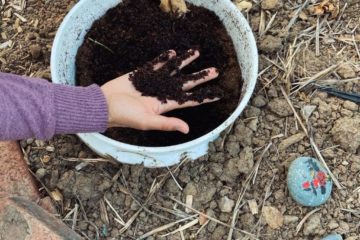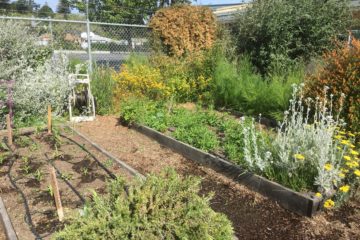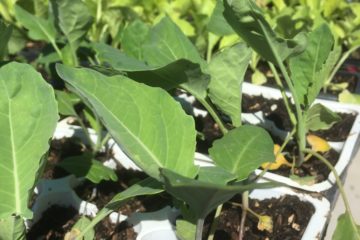When we think of ways to get rid of bugs in our gardens, pesticides are usually the first method that comes to mind. However, commercial pesticides introduce a host of environmental and health problems that should be avoided. For example, keep in mind that most gardens actually have more beneficial bugs and insects than pest insects. These beneficial insects and other organisms naturally help control pests, and they are called natural enemies. When pesticides are used, these natural enemies can be killed alongside the pests. So, it is important to observe your garden before using any kind of pesticide, and to encourage these beneficial insects by choosing plants that provide them with pollen, nectar, and shelter. Read more.
The USDA provides a really handy list of plants that will naturally repel each type of insect:
| Pest | Plant Repellent |
| Ant | mint, tansy, pennyroyal |
| Aphids | mint, garlic, chives, coriander, anise |
| Bean Leaf Beetle | potato, onion, turnip |
| Codling Moth | common oleander |
| Colorado Potato Bug | green beans, coriander, nasturtium |
| Cucumber Beetle | radish, tansy |
| Flea Beetle | garlic, onion, mint |
| Imported Cabbage Worm | mint, sage, rosemary, hyssop |
| Japanese Beetle | garlic, larkspur, tansy, rue, geranium |
| Leaf Hopper | geranium, petunia |
| Mexican Bean Beetle | potato, onion, garlic, radish, petunia, marigolds |
| Mice | onion |
| Root Knot Nematodes | French marigolds |
| Slugs | prostrate rosemary, wormwood |
| Spider Mites | onion, garlic, cloves, chives |
| Squash Bug | radish, marigolds, tansy, nasturtium |
| Stink Bug | radish |
| Thrips | marigolds |
| Tomato Hornworm | marigolds, sage, borage |
| Whitefly | marigolds, nasturtium |
Source: USDA website
Why should we use homemade pesticide instead of the usual ones we find at the stores?
Pesticides we find in stores most times have chemicals that can pollute water and the soil. They are usually not selective in which insects they kill, and can thus kill beneficial insects like ladybugs and spiders.
Using natural alternatives to pesticides will not just prevent all of these issues, but it will also save you money, since you probably already have most of the ingredients at home!
Some natural alternatives for chemical pesticides the USDA recommends:
- Non-detergent insecticidal soaps
- Garlic
- Hot pepper sprays
- 1 Teaspoon of liquid soap in a gallon of water, dishwater with soap residue, or forceful stream of water to dislodge insects.
Some examples of recipes:
- A combination of garlic cloves, mint leaves and cayenne pepper
- Oils like peppermint oil: (for aphids, thrips, spider mites and whiteflies)
- 1 tablespoon of dish soap
- 1 cup of cooking oil from a newly open bottle of oil
- Mix with water with a ratio of 4 teaspoons of oil mixture to 1 pint of water
- Store the oil mixture in a glass jar in a dark, dry and cool location
- Apply a liberal mist of the oil spray to the vegetables once every seven days to thoroughly control the pests
- Garlic spray:
- 10 to 12 garlic cloves
- 1 quart of water
- Combine it all in a blender. After blending, allow the mixture to set for 24 hours.
- Strain it through cheesecloth covering the opening of a glass jar
- Add 1 cup of cooking oil
- It can be stored for several weeks
- For an even more powerful homemade pesticide, add 1 tablespoon of cayenne pepper to the concentrated mixture and let it soak for another 24 hours before straining the liquid once again. When ready to use, dilute 1/2 cup of the liquid with 1 gallon of water.
Here are some more websites with more recipes as well!
- Homemade Organic Pesticide for Vegetables
- 5 Natural Pesticides You Could Use To Grow Your Own Kitchen Garden
How to apply:
- Before anything, test a bit of any homemade pesticide you make on a leaf before spraying on the whole plant to make sure it does not burn or damage the foliage. You should do this step some time ahead to give time for the plant to react, so maybe a day before you plan to use the mixture on your plants.
- The most convenient way is to use a spray bottle. Spray on the leaves, both top and underside.
- The prime time to apply the pesticide is early in the morning before the sun is too hot or late in the afternoon when there is no more direct sunlight. This is because most recipes contain oils and acidic compounds that can burn plants if used under full sun.
Written by Nathalia Frenhani Burini, Landscape Designer



0 Comments